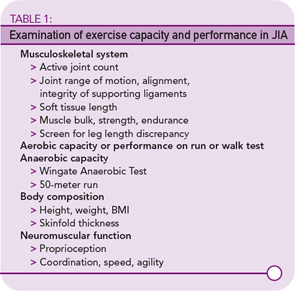While some children may require controlled laboratory tests of exercise capacity (VO2peak), the majority only need field tests of aerobic and muscular performance. Table 2 lists fitness tests that are generally safe and appropriate for children with arthritis and easily performed in the clinic or school setting. The Prudential FitnessGram, Physical Best, and Brockport Physical Fitness Test provide health fitness standards that are compatible with good health and prevention of the chronic diseases associated with a sedentary lifestyle. These test batteries also include training programs and software to track a child’s progress.
Exercise Prescription
Balanced rest and exercise are necessary to manage pain and maintain joint mobility and function. Table 3 illustrates the components of a general physical conditioning program. The individualized exercise prescription for a child with JIA should be graded to the child’s disease status and initial fitness level. During periods of acute arthritis, the goal is to prevent loss of motion and preserve normal alignment and integrity of the involved joints, while maintaining functional capacity. Daily active range of motion (AROM) or active–assisted range of motion (AAROM) exercises should target joints with active disease, as well as adjacent joints that are at risk for secondary loss of motion. The Arthritis Foundation book, Raising a Child with Arthritis: A Parent’s Guide, includes instructions and illustrations for ROM and postural exercises. I recommend doing ROM exercises during or after a warm bath or shower before bed to relax the child for sleep and reduce morning stiffness. Submaximal isometric contractions performed at multiple points in the pain-free ROM may preserve muscle bulk and strength during the acute stage. The child should also be encouraged to accumulate at least 30 minutes a day of low intensity aerobic activity that does not stress inflamed joints—for example swimming, walking in a warm pool, or riding a bike.
During subacute and chronic stages, AROM should continue, and the PT can also teach the child to perform gentle active stretches to lengthen shortened tissues. Encourage dynamic strengthening exercises; external resistance in the form of light hand or cuff weights or elastic bands can be added once the child is able to perform eight to 10 repetitions of the exercise against gravity without pain while maintaining good form. The amount of resistance is determined by the initial assessment of the child’s six to 10 repetition maximum, and should be increased when the child can perform sufficient reps with the current load. Encourage moderate intensity weight-bearing aerobic activities to improve fitness, build strength, and promote good bone density. Encourage parents to set aside exercise time and exercise with their child to improve adherence.



